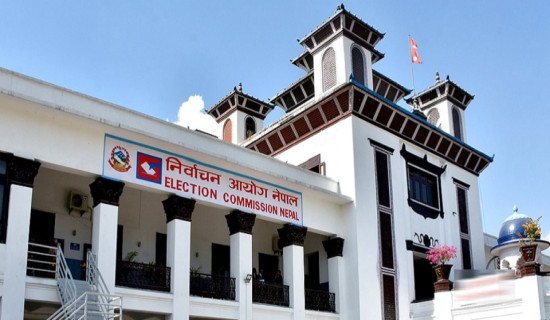- Thursday, 8 January 2026
Construction business facing unprecedented downturn
Kathmandu, Feb. 18: The construction industry in Nepal has been facing an unprecedented crisis which entrepreneurs call an ‘existential’ one. Overall, the construction business in the last year has been whittled down to a third of the total activities.
While it is the primary stakeholder in mobilising the government’s capital allocation (which is Rs. 302 billion for the current Fiscal Year 2023/24), it creates a market for construction materials, and other items like pipes and fittings, paints and electric products.
However, in the past more than one year’s period, both the public and private construction business has been slowed down.
This distress in the construction industry has its spillover effects on the business of construction materials like cement, iron bars, paints, pipes and fittings, electric goods, furniture and decorative items.
For example, the business of pipes and fittings has gone down by 40-50 per cent. “Business has decreased significantly. People are not building private houses, only medium and large industries and a couple of housing projects have continued with construction and maintenance works,” said Dipendra Poudel, Managing Director of Kamakhya Trade Pvt. Ltd., Kathmandu.
A study by the Nepal Rastra Bank (NRB) has found that the manufacturing sector in the country was running on an average of 42 per cent in the first half of the last Fiscal Year 2022/23. Likewise, approval for the map of house construction was down by 37.5 per cent during the same period. The situation has further deteriorated in the following months, said Er. Dhruba Thapa, President of the Cement Manufacturers Association (CMA).
While the installed capacity of cement industries has crossed the total domestic demand and the manufacturers have been urging the government to find alternatives like building concrete roads instead of asphalt to increase the demand, the recent recession in construction and development has intensified the crisis in the industries.
Iron bar industries are also experiencing the same crisis. Pashupati Murarka, former President of the Federation of Nepalese Chambers of Commerce and Industry (FNCCI) who heads Murarka Organization that also operates an iron and steel industry, said that the steel industry is running below 40 per cent of its capacity. In the aftermath of the COVID-19 pandemic, the industries were running at about 90 per cent.
“The market has gone down as there are less construction works, increased number of steel industries, government’s failure to spend the budget and liquidity on the part of common people,” said Murarka.
Meanwhile, iron industries that relied on MS Billet to produce rods have been on the verge of collapse as the government two years ago abolished the customs duty on sponge iron but continued a 5 per cent import duty and Rs. 2.5 per kg excise duty on MS Billets, another raw material for iron bars.
Kiran Sakha, Managing Director of Sakha Steel, said that the government has been highly apathetic to their problems. Half of the 32 steel industries are in crisis due to the government’s decision to exempt duty on sponge iron, implemented through the budget announced by then Finance Minister Janardan Sharma.
This many-sided recession in construction and manufacturing has resulted in the loss of jobs of about 1.5 million people, with about a million losing their jobs in the construction sector alone.
According to Rabi Singh, President of the Federation of Contractors Associations of Nepal (FCAN), the construction industry was providing direct employment to 2 to 2.5 million people. This job loss is seen across various sectors of manufacturing, and supporting activities like transportation, house wiring, painting and furniture.
FCAN said that about 1,800 projects of about Rs. 400 billion are awaiting deadline extension from the government. Likewise, the government has a liability to clear Rs. 40 billion to the contractors. Furthermore, the contractors have not been paid about Rs. 10 billion for the ongoing projects.
The FCAN also said that the construction of about 800 projects is pending as the government couldn’t clear the land, assure the budget and provide appropriate design. It is pressing the government for the extension of deadlines for the projects that suffered a backlog of about 9 months to 1 year due to the government restrictions on crusher industries that resulted in a shortage of stones, sand and gravel, and construction couldn’t be continued.
The Ministry of Home Affairs in January 2023 had decided to close all crusher industries and quarry works operating illegally. A large number of crusher industries fell in the illegal category due to the provision of a 2-kilometre distance from villages, educational institutions, religious and cultural areas, forests and security establishments, and 500-metre far from river banks and highways. Most of the crusher industries are near rivers, forests, human settlements or highways.
Loans to private sector
Statistics on loan mobilisation are not encouraging either. Domestic credit increased 2.6 per cent in the first half of this FY 2023/24 compared to an increase of 2.8 per cent in the corresponding period of the previous year.
According to the Nepal Rastra Bank (NRB), private sector credit from BFIs increased by Rs. 192.64 billion (4.0 per cent) in the six months of this year compared to an increment of Rs. 137.33 billion (3.0 per cent) last year. Two years ago, the private sector credit from BFIs in the first half saw an increase of Rs. 492.63 billion (12.1 per cent).
Meanwhile, the lending rate of banks has also been moderated and commercial banks’ weighted interest rate has come down to 11.38 per cent in mid-January this year from 12.79 per cent a year earlier. Such rates in development banks and finance companies is 13.14 per cent and 14.09 per cent. However, this is still about two per cent higher compared to the average interest rate of 9.44 per cent in mid-January 2022.
Prime Minister Pushpa Kamal Dahal and Finance Minister Dr. Prakash Sharan Mahat have been repeatedly assuring the private sector to keep the interest rate to a single digit.
However, a banker said that the leaders should stop making any promises or claims against the market practice as the interest rates of the bank are determined by the demand and supply in the financial system. Governor of the NRB, Maha Prasad Adhikari has also been voicing the same concern.
Facilitating construction business
The earlier boom in the construction of private houses in Nepal was backed by an inflated profit margin in the real estate business, a booming share market and low-interest loans by the banks.
These opportunities were lost as the real estate and share market crashed with the share market index going below the 1,900 mark from above 3,100 and real estate transactions discouraged by high-interest rates, a ban on splitting land pieces and crisis in the cooperative sector where more than Rs. 75 billion of lower-middle and middle-class people is stuck significant part of which is not likely to be recovered.
A ray of hope is exhibited by the increased remittance inflow which witnessed an upward trend of 25.3 per cent to Rs. 733.22 billion in the first half of the current fiscal year. However, this amount is scattered among millions of households across the country and a large chunk of it is used in financing daily essential goods and paying utility and education bills.
Poudel said that people don’t have money to build their houses or even carry any minor construction works like building boundary walls and other maintenance. Meanwhile, the price of house construction has increased to Rs. 4,200 per square foot now from Rs. 3,500 a year earlier.
“There are no symptoms of early improvement in the situation. This is a cross-cutting issue and multiple stakeholders should intensify efforts to weed out the problems and facilitate the business. But in the case of Nepal such cooperation is not forthcoming,” said Singh.
Likewise, Thapa of CMA said that the government should devise a better strategy to promote development and construction. There should be an environment to run construction work throughout the year contrary to the current practice of doing it in the second half of the year, he said. He also suggested the government secure domestic or international borrowing to finance development work and offer much-needed impetus to the construction and related industries.
Similarly, according to Murarka, housing loans should be promoted and the NRB directive that bars banks and financial institutions to mobilise loans to a second house of the same person should be revised.
More than 40 per cent of the capital allocation should be utilised in the first half of the fiscal year if the country wants to stimulate rapid development and economic growth. Since the country is in dire need of quality physical infrastructure, public facilities and construction, the government and private sector should find a way to promote sustainable growth in this sector.
Ministry of Physical Infrastructure and Transport (MoPIT), Ministry of Urban Development (MoUD), Ministry of Energy, Water Resources and Irrigation (MoEWRI), Ministry of Industry, Commerce and Supplies (MoICS), Department of Industry and Investment Board of Nepal at the federal level and provincial infrastructure and industry ministries as well as local bodies should play a proactive role for better mobilisation of the capital budget.
Need for better coordination
Minister for Physical Infrastructure and Transport, Prakash Jwala, said that the current crisis is a cumulative impact of multiple decisions and problems such as a temporary ban on crusher industries, restriction on land-splitting and poor development expenditure.
“This is not an issue that the Infrastructure Ministry can address single-handedly. Development ministries like MoUD, MoEWRI, and MoICS also spend a large amount of capital budget,” he said. “However, we are extending facilitation in resolving the issues in the critical projects like Narayangadh-Butwal Road Expansion.”
Minister Jwala said that there have been multiple rounds of discussions with the contractors and other development stakeholders in facilitating the payment and construction. However, these efforts have yet to bear any fruits.
The MoPIT is also struggling to address the demands of the contractors as the latter have asked to provide a blanket solution to the problem which the Ministry is hesitating to accept. It said that only appropriate demands should be addressed.












-original-thumb.jpg)



